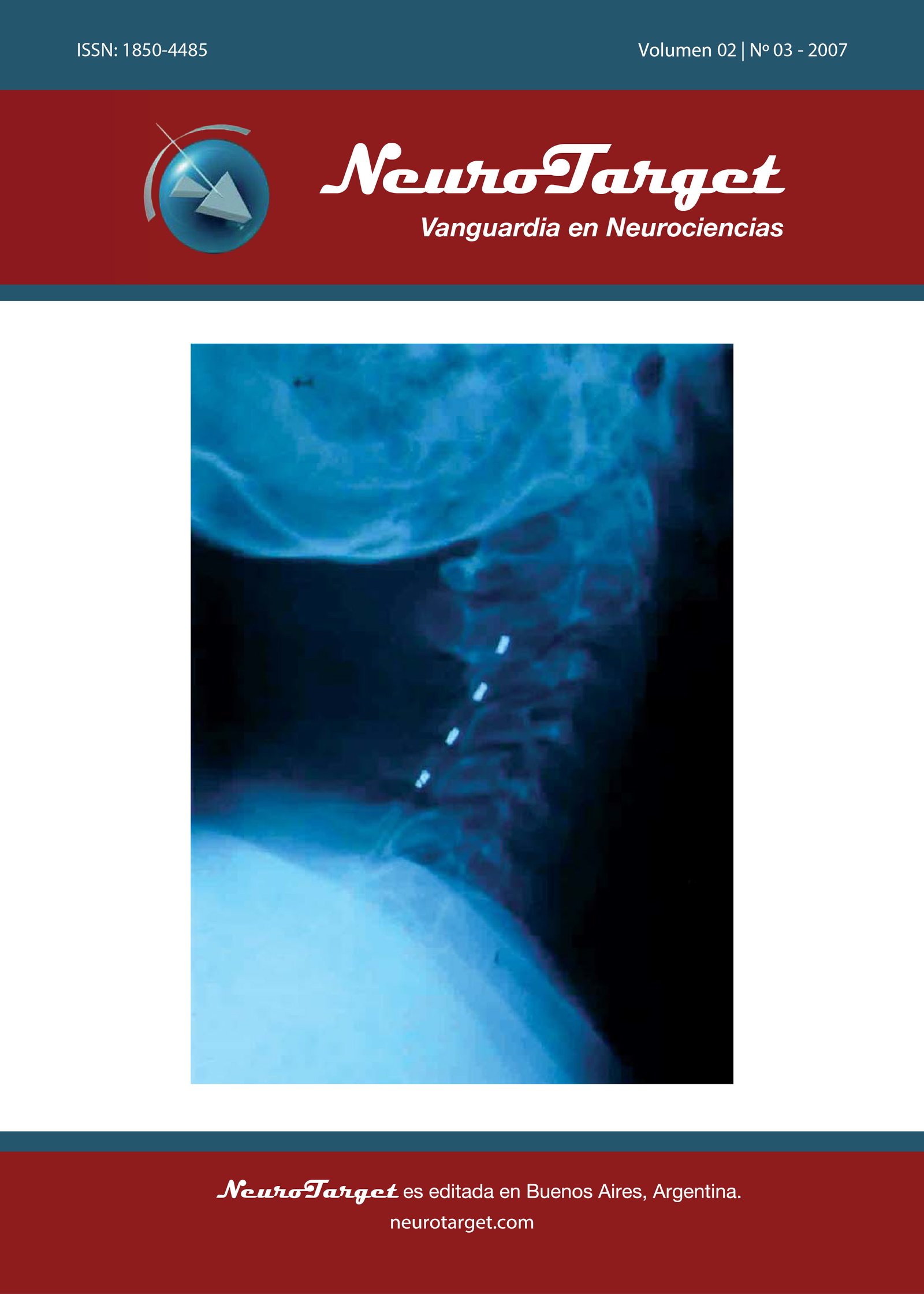Craniotomy and stereotaxy-guided volumetric resection in patients with refractory epilepsy
DOI:
https://doi.org/10.47924/neurotarget2007365Keywords:
guided/assisted craniotomy, steretactic volumetric resection, intra-surgical awakening, cortical functional mappingAbstract
Introduction: We present the outcomes of a retrospective study on a series of 60 consecutive patients with intraaxial brain damage, who were operated on using multimodal methods, including craniotomy and volumetric resection guided by estereotaxy, cortical functional mapping, and intra-surgical awakening.
Patients and Methods: Between March 1999 and January 2007, 216 patients had been operated on with estereotatic methods, at Hospital Neurológico de la Liga Colombiana contra la Epilepsia, Clínica MediHelp, Clínica Madre Bernarda and Hospital Bocagrande, in Cartagena de Indias, Colombia. Among inclusion criteria intraaxial brain damage located at eloquent, deep and/or epilepsy producers areas were considered as well as the use of stereotatic continuous guide intrasurgical procedure. Presurgical assessments/tests had been undergone in all patients following the institutional protocol. In all cases, a ZD stereotatic equipment/device (Laibenger-Fischer), Stereo Plan 2.0 software and brain TAC/RM with contrast was used. Neurolepto-anesthesia was the anesthetic technique applied. Intra-surgical awakening and cortical functional mapping using Berger and Ojemann´s parameters were used. Craniotomy and resection were carried out by continuous stereotactic assistance/guide.
Outcomes: In total, 216 patients had been operated on with stereotactic methods; 60 of them experienced continuous stereotactic guide/assistance. 34 were males (53%) and 26 females (47%), between 14 and 70 years of age (average: 42). Pathologies found: tu- moral, in 46 cases (76.6%), vascular, in 9 (15 %), other pathologies 8.3%. Complications related to surgery arouse with 10 patients (16.6% of the cases).
Conclusion: The multimodal approach (craniotomy and volumetric resection guided by stereotactic + cortical functional mapping + intra-surgical awakening) allows for total resections or subtotal extensive resections of brain damages located in eloquent, deep and/or epilepsy producer areas, with lower morbimortality rate than in conventional procedures.
Metrics
References
Berger MS. Functional mapping-guided resection of low-grade gliomas. Clin Neurosurg. 1995;42:437-52.
Berger MS, Rostomily RC. Low grade gliomas: functional mapping resection strategies, extent of resection, and outcome. J Neurooncol. 1997 Aug;34(1):85-101.
Gugino LD, Aglio LS, Raymond SA, Romero R, Ramirez M, Gonzalez A, et al. Intraoperative Cortical Function Localization Techniques. Tech Neurosurg. 2001;7(1):19-32.
Brell M, Conesa G, Acebes JJ. [Intraoperative cortical mapping in the surgical resection of low-grade gliomas located in eloquent areas] [Article in Spanish] Neurocirugia (Astur). 2003 Dec;14(6):491-503.
Barnett GH: Stereotactic techniques in the management of brain tumors. Contemp Neurosurg. 1997;19(10):1-9.
Heffez DS. Stereotactic transsylvian, transinsular approach for deep-seated lesions. Surg Neurol. 1997;48(2):113-24.
Spencer DD, Spencer SS, Mattson RH, Williamson PD. Intracerebral masses in patients with intractable partial epilepsy. Neurology. 1984;34(4):432-6.
Lombardi D, Marsh R, de Tribolet N. Low grade glioma in intractable epilepsy: lesionectomy versus epilepsy surgery. Acta Neurochir Suppl. 1997;68:70-4.
Goldring S, Rich K, Picker S. Experience with gliomas in patients presenting with a chronic seizure disorder. Clin Neurosurg. 1986;33:15-42.
Berger MS, Ghatan S, Haglund MM, Dobbins J, Ojemann GA. Low-grade gliomas associated with intractable epilepsy: seizure outcome utilizing electrocorticography during tumor resection. J Neurosurg. 1993;79(1):62-9.
Berger MS, Deliganis AV, Dobbins J, Keles GE. The effect of extent of resection on recurrence in patients with low grade cerebral hemisphere gliomas. Cancer. 1994 ;74(6):1784-91.
Berger MS, Ojemann GA. Intraoperative brain mapping techniques in neuro-oncology. Stereotact Funct Neurosurg. 1992;58(1-4):153-61.
Kelly PJ. Volumetric stereotactic surgical resection of intra-axial brain mass lesions. Mayo Clin Proc. 1988;63(12):1186-98.
Kelly PJ. Stereotactic technology in tumor surgery. Clin Neurosurg. 1989;35:215-53.
Kelly PJ. Computer assisted volumetric stereotactic resection of superficial and deep seated intra-axial brain mass lesions. Acta Neurochir Suppl (Wien). 1991;52:26-9.
Russell SM, Kelly PJ. Volumetric stereotaxy and the supratentorial occipitosubtemporal approach in the resection of posterior hippocampus and parahippocampal gyrus lesions. Neurosurgery. 2002;50(5):978-88.
Piepmeier J, Christopher S, Spencer D, Byrne T, Kim J, Knisel JP, et al. Variations in the natural history and survival of patients with supratentorial low-grade astrocytomas. Neurosurgery. 1996;38(5):872-8; discussion 878-9.
Philippon JH, Clemenceau SH, Fauchon FH, Foncin JF. Supratentorial low-grade astrocytomas in adults. Neurosurgery. 1993;32(4):554-9.
Downloads
Published
How to Cite
Issue
Section
License
Copyright (c) 2007 Juan Carlos Benedetti

This work is licensed under a Creative Commons Attribution 4.0 International License.
The article is distributed under the Creative Commons Attribution 4.0 License. Unless otherwise stated, associated published material is distributed under the same licence.







